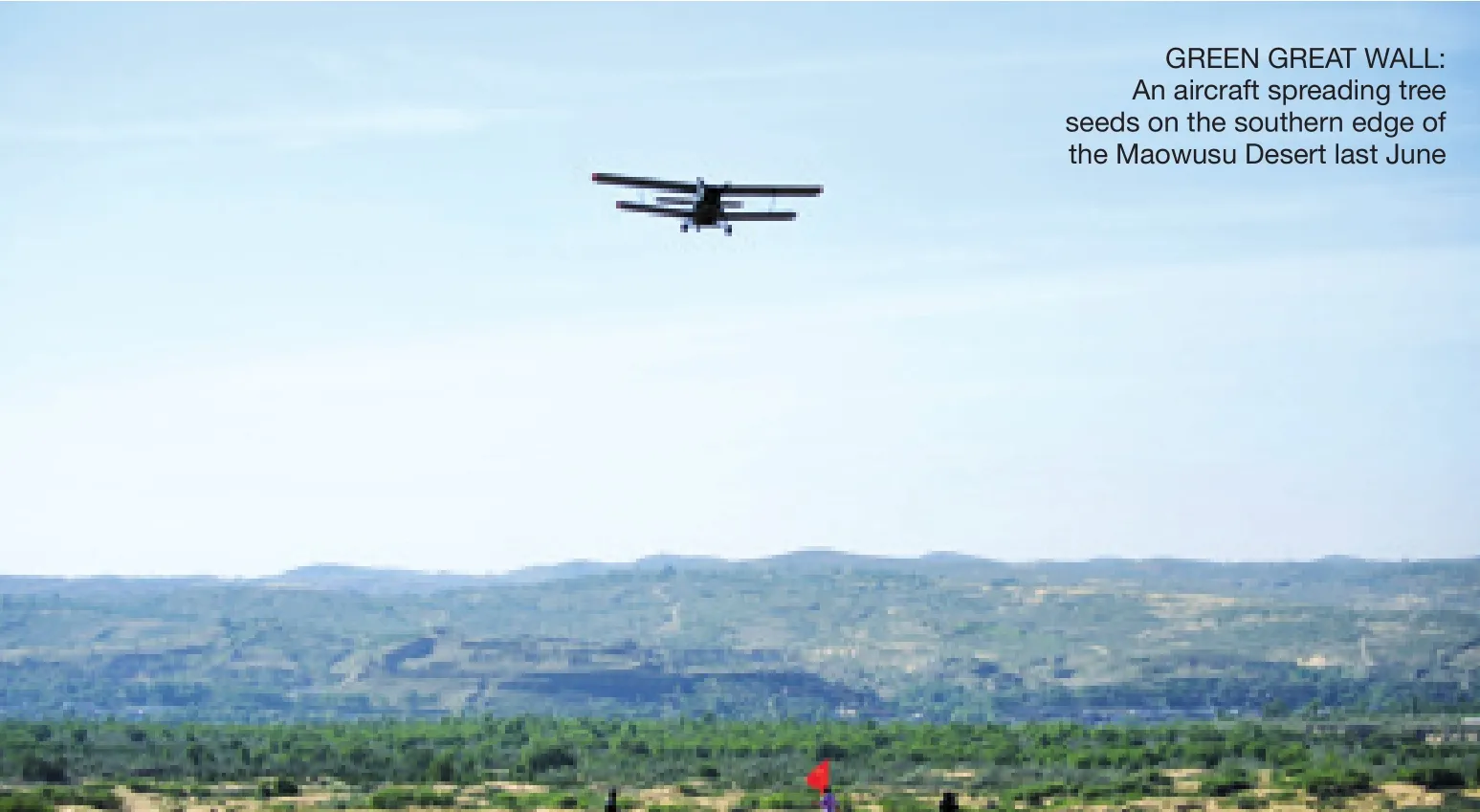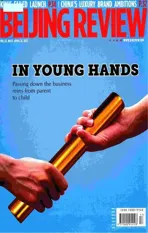Stopping Sand
2012-10-16AnintegratedindustrialmodeshowspromiseinfightingagainstdesertificationByHuangWei
An integrated industrial mode shows promise in fighting against desertification By Huang Wei
Stopping Sand
An integrated industrial mode shows promise in fighting against desertification By Huang Wei

MOUNTAINS OF SAND: The photo shows tamarisks planted on the edge of the Maowusu Desert in Yulin City, Shaanxi Province, to prevent deserti fi cation
A biomass thermoelectric project’s successes in combating desertification in China’s Maowusu Desert drew much attention at the Third Intersessional Meeting of the United Nations Conference on Sustainable Development (UNCSD) on March 26.
Scientists from China introduced their efforts to combat desertification, reduce carbon emissions and improve people’s livelihoods at a side event concerning the sustainable development of Inner Mongolia. The symposium was cosponsored by China’s State Forestry Administration,the Government of Inner Mongolia Autonomous Region, and Inner Mongolian Maowusu Biomass Thermoelectric Co.
“The Chinese Government has made outstanding achievements over the past several years by means of planting trees, with the Maowusu project as one of the successful cases,”said Sha Zukang, UN Undersecretary General for Economic and Social Affairs, and Secretary General of Rio+20 of the UNCSD. “The project made great efforts in dealing with global climate change, shouldering social responsibility and developing green economy, and its experiences are worth learning from,” added Sha.
French botanist Andre Aubréville coined the term “desertification” to describe the process by which fertile land becomes desert.Since the 1990s, the issue has drawn attention from scientists and the governments of many countries. The UN has convened many special conferences to discuss methods of preventing this form of land degradation, which is often caused by inappropriate agricultural methods,overgrazing, climate change and soil erosion.
In 1992, the UN Earth Summit was held in Rio de Janeiro, where representatives of countries worldwide discussed speci fi c ways to implement sustainable development. One of the outcomes of that summit was the adoption of Agenda 21, the UN action plan for the 21st century. It is a comprehensive blueprint of action to be taken globally, nationally, and locally by the UN, governments, and major organizations in every area in which humans directly affect the environment.
In October 1994, representatives of countries in the world adopted United Nations Convention to Combat Deserti fi cation. In the convention, deserti fi cation was de fi ned as “land degradation in arid, semi-arid and dry sub-humid areas resulting from various factors, including climatic variations and human activities.”
Currently, one third of the world’s landmass are threatened by desertification,resulting in an increasingly austere impact on society, economy and environment. Many countries list deserti fi cation and land degradation as a challenge to long-term social and economic development.
China has the largest area of land affected or threatened by deserti fi cation in the world according to the State Forestry Administration. By the end of 2009, the country had 2.62 million square km of degraded or degrading land, and 1.73 million square km of deserti fi ed land, as well as 310,000 square km land showing an apparent tendency toward deserti fi cation.
Challenges
There has long been a dispute on methods to combat deserti fi cation and relations between deserti fi cation control and sustainable development.
A surprisingly large portion of sandy areas in the world contain water, and only 50 cm beneath the surface of most deserts,the humidity content is around 5 percent.Far from being dead wastelands, desert ecosystems typically contain enough water to support plant growth.
“Planting trees is a common method to fight against desertification,” said Li Jinglu,General Manager of the Maowusu Biomass Thermoelectric Co. However, maintaining the shrubs requires signi fi cant investments, a big challenge, as shrubs need constant cutting to survive, according to Li.
“Planting trees is only the beginning. A fundamental way to protect desert ecosystems is to perform maintenance on the trees every three or four years to keep them alive, otherwise, the efforts will be in vain,” Li said.Green areas covered by trees a decade ago might degrade to their original state.
Repay in kind
The Maowusu Desert, located between Yulin City in central China’s Shaanxi Province and Ordos City in Inner Mongolia, is one of the four largest deserts in China. Uxin Banner in southern Inner Mongolia is located in the center of Maowusu. Covering an area of 11,645 square km, Uxin is a region where 94.8 percent of land is affected by deserti fi cation.Combating soil erosion is a cruel fact of life the banner must face.
The Maowusu Biomass Thermoelectric Co. is situated in Uxin, where Li has worked for nine years.
The company operates a thermoelectric power plant using shrub trimmings as fuel.While harvesting energy from the combustion of biomass, the power plant also sequesters carbon dioxide emissions to cultivate spirulina, a type of algae that can be used as a nutritional supplement.
In this way, a unique industrialized mode of fighting desertification has taken shape,producing environmentally friendly electricity, improve people’s livelihoods and reducing emissions. This circular industrial system recycles carbon and uses sand to fi ght sand.
“The core to utilize new energy in desert area is to control deserti fi cation,” said Li. The shrubs develop usable bush wood and require pruning in three to fi ve years in order to fl ourish.
“This is a solution to combat deserti fi cation, develop biomass energy and materialize low-carbon production and emission reduction,” Li toldBeijing Review.
Maowusu’s thermoelectric power project,put into operation in November 2008, has invested an average of 50 million yuan ($7.9 million) annually in late shrub maintenance,including an industrialized chain of planting,nursing, cutting, transporting and processing.The project created about 8,000 jobs, and increased the annual incomes of local herdsmen by more than 70 million yuan ($11 million).

CHEN TUANJIE
Industrial role model
Su Zonghai, Undersecretary General of the China Green Carbon Foundation, analyzed the project’s performance in the Beijing-basedForestry Economicsmagazine.
“‘Three-carbon economy’ [carbon absorption, carbon emission reduction and carbon sequestration], an industrialized mode to combat desertification, is not only a typical recycling economic mode, but also a new eco-economic development mode integrating well with forestry of carbon sinks, low-carbon economy, and ecological construction.
The project, with a total investment of 500 million yuan ($79 million), has thus far: treated 24,000 hectares of desert; built a fi rst-phase spirulin-production item by using sequestered carbon dioxide emitted during electricity generation; and produced over 240 million kilowatt-hours of electricity with the 30,000-kilowatts thermoelectric plant. The company realized a production chain of planting trees to fight desertification and absorb carbon dioxide. Trimmings from those trees fuel the power plant, which traps carbon dioxide emissions which are in turn sequestered within the spirulin-producing algae.
The Maowusu project is considered an industry exploring the improvement of human environment, and a model item providing healthy food. The project exposed desert value as a resource, integrated human living environment with human health, and achieved sustainable development through an industrialized recycling chain process.
Luc Gnacadja, Executive Secretary of UN Convention to Combat Desertification,spoke highly of the Maowusu project at the symposium. He hoped the approach could be introduced as a good model for African and other developing countries and become a best practice globally to fi ght deserti fi cation.
